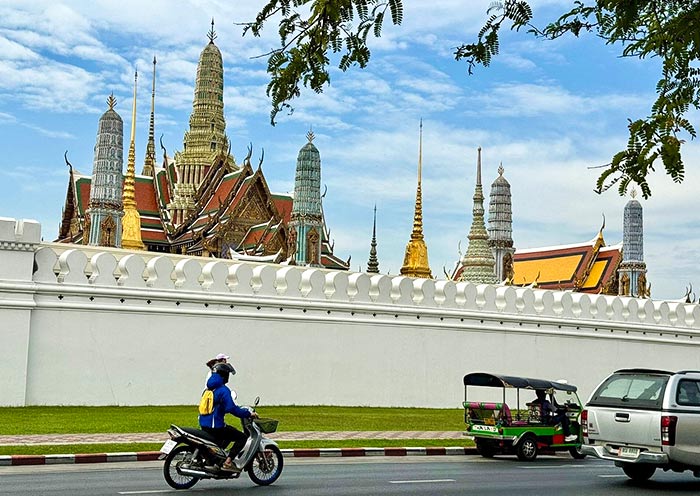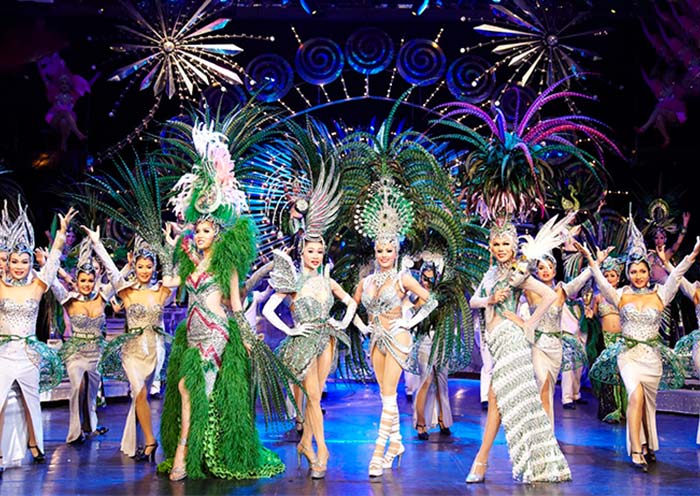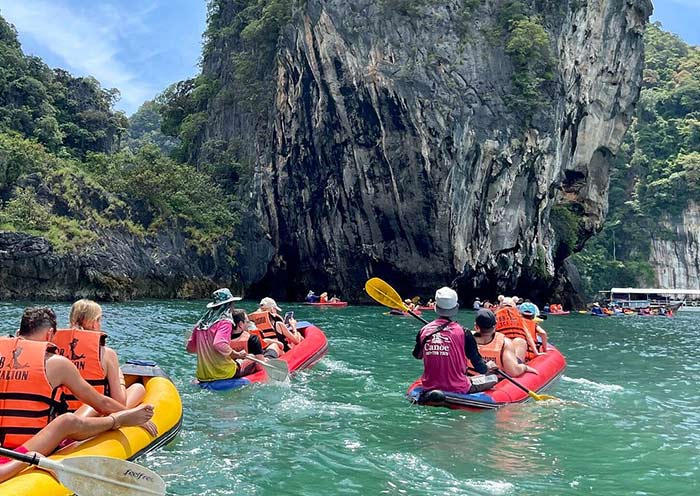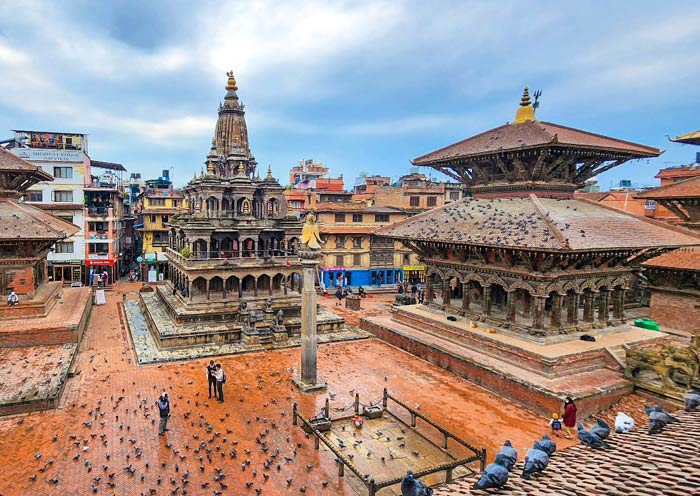We traveled with 7 lady friends. Our trip with Asia Odyssey Travel was so well planned, and seamless. Our time in Bhutan was exceptional, being led by Ugyan and Doji. What two very wonderful men. They were both so very knowledgeable, kind, and helpful. I cannot say enough good about our time in Bhutan with these two good men,...our guide and driver. Thank you Asia OdysseyTravel!!! p.s. Our trip was planned by Tony of Asia Odyssey. He was amazingly helpful, and planned our trip flawlessly! Thank you, Tony!
10 Days Thailand Bhutan Tour from Bangkok to Paro, Thimphu, Punakha & Gangtey
- Highlights
- Itinerary
- Price
- Trip Notes
- Accommodation
- Photos
- Reviews
Explore 2 Buddhist Kingdoms Located in Southeast Asia & the Himalayas
Why the Bhutan Tour from Thailand? Why combine Thailand and Bhutan in one trip? Take our 10 Days Thailand Bhutan Tour from Bangkok to discover the differences between the two Buddhist Countries. Both Thailand and Bhutan are Buddhist Kingdoms, though one is located in bustling Southeast Asia while the other is hidden in the mystery Himalayas. What is more, Thailand is the best gateway to start a Bhutan trip as there are many direct flights from Bangkok to Paro of Bhutan.
Known as the City of Angels, Bangkok is not only the capital city of Thailand but also topped the list of the world's most-visited cities for tourists in 2023. In Bangkok, you can discover two treasures of Thailand (the Jade Buddha and the Reclining Buddha), explore top attractions like Wat Phra Kaew, the Grand Palace, Wat Arun, and Chinatown, and experience Thai food, Thai massage, and boat tours.
Then, take a flight to Bhutan, the Land of Happiness. You will explore key destinations of Bhutan, including Paro, Thimphu, Punakha, and Gangtey, for a perfect blend of culture and nature. Visit majestic dzongs and ancient monasteries (Tiger's Nest) that showcase Bhutan's spiritual and historical depth. Venture off the beaten path to the pristine Phobjikha Valley, known for Gangtey Monastery and Black-Necked Cranes. Immerse yourself in Bhutanese customs by trying traditional attire and archery, and savor the unique flavors of Bhutanese cuisine.
Join our Thailand Bhutan Tour from Bangkok for an extraordinary travel experience that captures the heart and soul of the 2 Buddhist Kingdoms Located in Southeast Asia & the Himalayas.
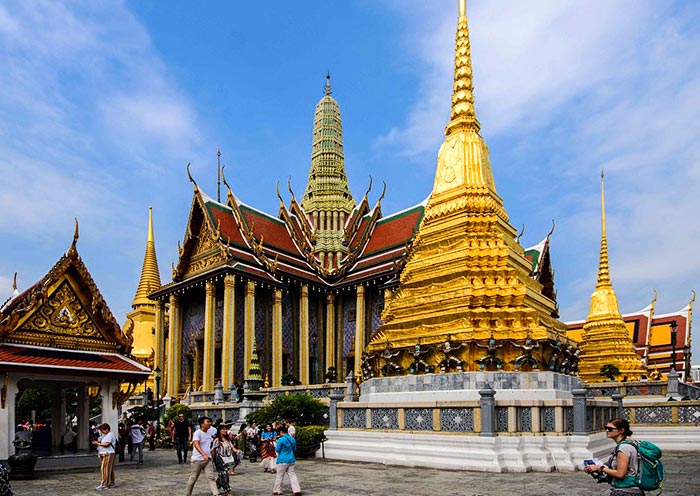

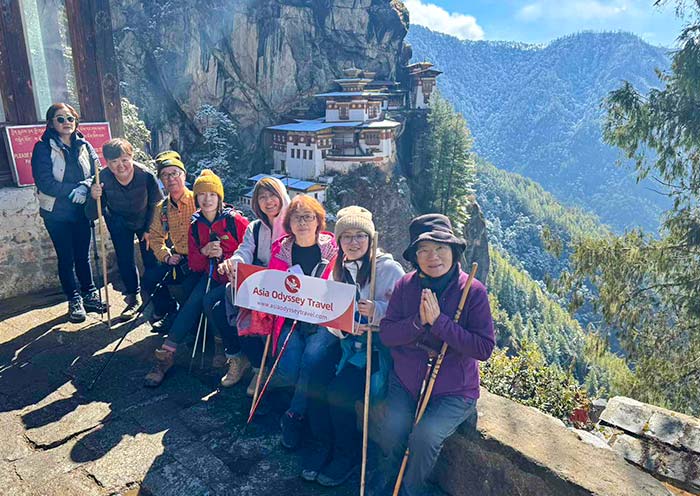
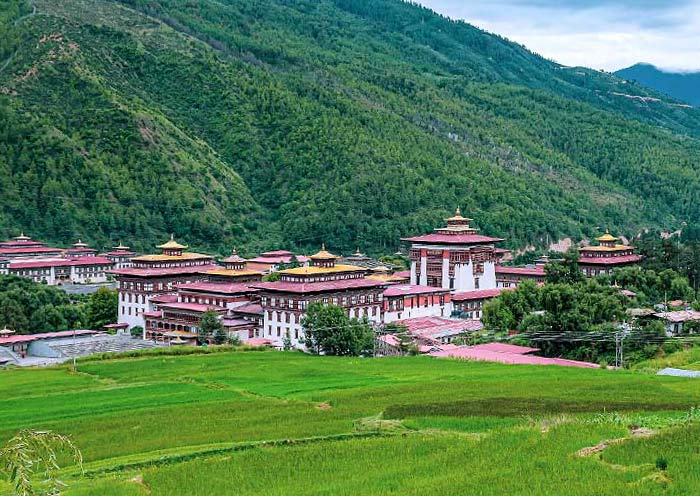





Itinerary at a Glance
Bangkok (2 Days)
Wat Phra Kaew, Grand Palace, Wat Pho, Chinatown, Wat Arun
Paro (3 Days)
Tiger's Nest Monastery (Taktsang Goemba, Takhtsang Lhakhang, Paro Taktshang), Drukgyel Dzong, Kyichu Lhakhang, Tamchog Lhakhang, Paro Airport Birds Eye View Point, Rinpung Dzong, National Museum
Thimphu (2 Days)
Motithang Takin Preserve, Tashichho Dzong (Thimphu Dzong), Buddha Dordenma Statue, National Memorial Chorten, Folk Heritage Museum, Bhutan Post Office, School for Arts and Crafts
Punakha (2 Days)
Dochula Pass, Chimi Lhakhang, Punakha Dong, Punakha Suspension Bridge, Khamsum Yulley Namgyal Chorten
Gangtey (1 Day)
Gangtey Nature Trail, Phobjikha Valley, Black-necked Cranes Center
Itinerary Day by Day
Sawatdee Krap/Kha! Welcome to Bangkok, the capital city of Thailand! Upon your arrival at the airport in Bangkok, the tour guide and driver will meet you at the exit and then escort you to the hotel in downtown Bangkok. You can have a good rest in your hotel and get ready to explore Bangkok with your guide the next day.
Bangkok means the "City of Angels" in translation from its ceremonial Thai name, Krung Thep Maha Nakhon. It is a vibrant metropolis known for its bustling markets, ornate temples, and delicious Thailand street food. You can indulge in Bangkok's diverse culinary scene, from street eats to upscale dining. Shop till you drop in luxury malls or explore local markets. Enjoy the city's lively nightlife, rooftop bars, and live music venues. Bangkok offers a blend of tradition and modernity, making it an exciting and captivating destination.
Free Time Ideas:
1. You can watch a Thailand boxing game at Rajadamnern Stadium.
2. Unwind with a traditional Thai massage or spa treatment.
Arrival Ideas:
Bangkok, the capital city of Thailand, serves as a significant international hub with direct flights from various cities worldwide. Major cities offering direct flights to Bangkok include London, Dubai, Singapore, Kuala Lumpur, Ho Chi Minh City, Doha, Taipei, Hong Kong, Frankfurt, Paris, Helsinki, Beijing, New York, Los Angeles, Tokyo, and Sydney. Many cities in Thailand, such as Chiang Mai (Chiang Mai International Airport), Phuket (Phuket International Airport), Krabi (Krabi International Airport), and Koh Samui (Samui International Airport ), also have direct flights to Bangkok's main airports, Suvarnabhumi Airport (BKK) and Don Mueang International Airport (DMK). Flight availability and routes can vary based on airlines, seasons, and other factors. It is recommended to consult airlines or our travel consultant for the most up-to-date information regarding direct flights to Bangkok from your specific location.
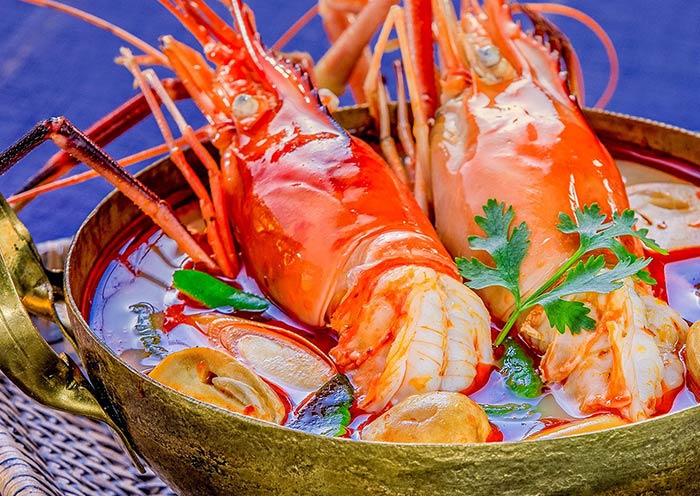
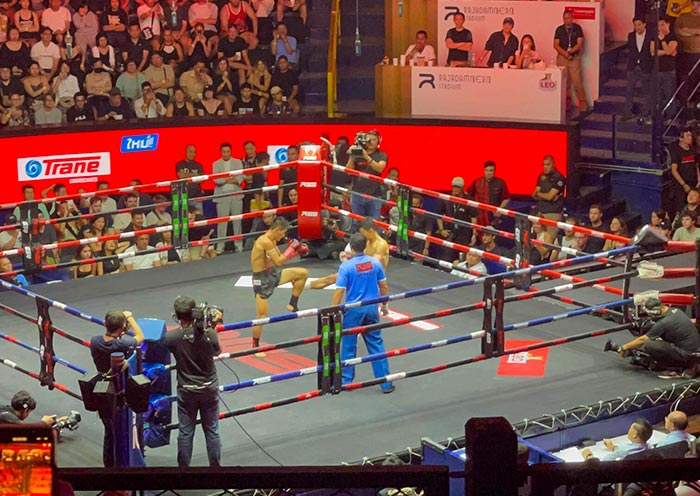
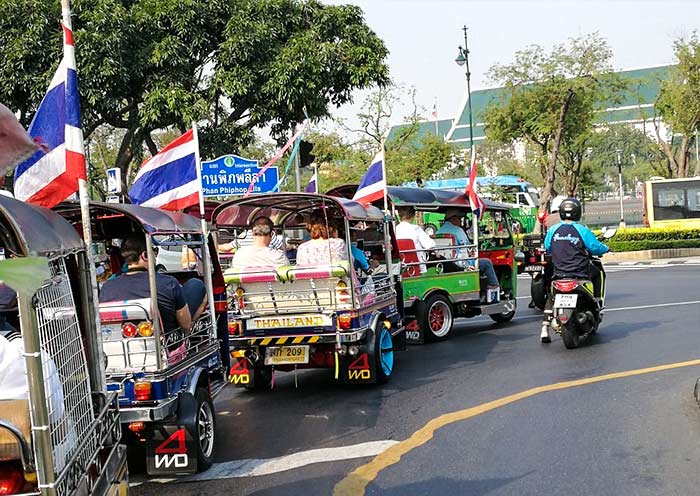
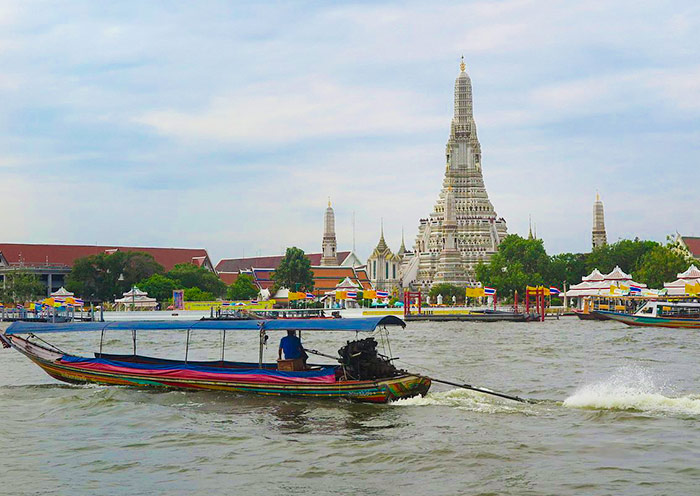
Today, you will explore the Top 5 must-visit places in Bangkok: Wat Phra Kaew, Grand Palace, Wat Pho, Wat Arun, and Chinatown. You see “Wat” means “Temple” in Thai language. You will also experience a Thai tuk-tuk, take a ferry or boat ride on the Chao Phraya River, and indulge in local food in Chinatown. This is a classic Bangkok trip, allowing you to witness 2 of the three treasures of Thailand: the jade Buddha and the reclining Buddha.
In the morning, head to Wat Phra Kaew which was built in 1782 and is located in the northeast corner of the Grand Palace in Bangkok. Covering one-fourth of the Grand Palace's area, Wat Phra Kaew is the most famous royal Buddhist temple in Thailand. This temple is renowned for enshrining one of three national treasures of Thailand, the Emerald Buddha, which is carved from a single block of Emerald. Each year, the Thailand King personally changes the Buddha's robes according to Thailand's three unique seasons. Each season changes with a certain robe: a gold robe embedded with rubies for the hot season, a gold robe embedded with sapphires for the rainy season, and a pure gold robe for the cool season. Don’t forget to check which robe the Emerald Buddha wears when you are there.
On the walls surrounding the cloisters of Wat Phra Kaew, there are a total of 178 murals (1,000m in length). Painted during the reign of King Rama I, the first monarch of the Chakri Dynasty in 18th-century Thailand (Bangkok Dynasty), the murals depict scenes from the Indian mythological epic "Ramayana," which narrates the story of King Rama joining forces with the monkey deity Hanuman to defeat the demon king Ravana and rescue the exquisite princess Sita. It is said that the story of the "Journey to the West" is also based on this legend. All the murals were created by royal court painters and the golden pigments used were made entirely from gold, resulting in exquisite and unparalleled artwork.
With the guidance of your tour guide, you can learn about the mythical creatures within Thai Buddhist architecture. For example, there is the Garuda, a mythical bird and guardian deity of Buddhism, perched on the rooftops. At the entrance of the temple, you'll find Yaksa, a protective deity, and outside the halls, there are statues of Kinaree, a mythical half-bird, half-human creature. The base of the pagoda is adorned with statues of Hanuman, the monkey deity.
After visiting Wat Phra Kaew, you can go on a visit around the Grand Palace. The Grand Palace, which was first established in 1782, was constructed as a replica of the old palace in the former capital city of Ayutthaya. It serves as a symbol of the Bangkok Dynasty and is the most well-preserved, largest, and most distinctive palace in Thailand. The Grand Palace is currently used for coronation ceremonies, royal celebrations, and hosting foreign dignitaries. From King Rama I to King Rama VIII, all the monarchs of the Bangkok Dynasty resided in the Grand Palace. However, after an assassination incident in 1946 involving King Rama VIII, King Rama IX moved to a new residence. The Bangkok Dynasty has continued to the present day, with the current monarch being King Rama X.
The Grand Palace complex consists of 22 buildings and is elegantly situated along the banks of the Chao Phraya River. The main structures are four distinct palaces (Borombhiman Hall, Amarindra Hall, Chakri Mahaprasat, Dusit Hall), showcasing the essence of Thai architecture, painting, sculpture, and interior decoration. It is often referred to as the "Encyclopedia of Thai Art". By the way, the Thai King is considered the incarnation of the god Vishnu, and Garuda is Vishnu's guardian. As a result, sculptures of the Garuda (stepping on 2 serpents) can be found on door lintels, eaves, and walls, with a total count exceeding several hundred. Witnessing the changing of the guards' ceremony is a bonus when visiting the Grand Palace.
Then, visit Wat Pho (Temple of the Reclining Buddha) which is a 10-minute walk from the Grand Palace. As the oldest and largest temple in Bangkok, Wat Pho houses the largest reclining Buddha and the highest number of Buddha images and stupas in the city. The reclining Buddha, one of three national treasures of Thailand, is 46 meters tall and 108 meters long, depicting the scene of the Nirvana of Gautama Buddha. Within the temple grounds, there is a Bodhi tree, believed to be the spot where the Buddha meditated. The temple is adorned with about 100 stupas, with the most magnificent being the four stupas which are decorated with blue, white, yellow, and green ceramic tiles. In the courtyard, you can also see many Chinese-style stone sculptures, such as door guardians and lions, which were traditionally used on ships for ballast and protection against evil spirits.
Wat Pho is regarded as Thailand's first university and is considered the birthplace of Thai medicine and traditional Thai massage. It still houses a private school established in 1957 that teaches traditional Thai medicine and offers authentic Thai massages (optional, self-pay).
In the afternoon, take a ferry or boat (cruise; optional) on the Chao Phraya River to view Wat Arun (outside view). The Chao Phraya River divides Bangkok into two parts, and many famous temples are concentrated along its banks. The Wat Arun, is one of the most prominent temples that stands on the river's edge, complementing the Grand Palace on the opposite side. (Note: Due to the hot weather and the presence of numerous steps at Wat Arun, many of our guests opt to take a boat trip and enjoy the view of Wat Arun from the outside, either from the boat itself or from the opposite side.)
Built in 1809, Wat Arun was established to honor King Taksin (郑信), the 41st monarch of Thailand (1767-1782) and a national hero. During the invasion of the Burmese army, King Taksin led the Thai people in a brave resistance, successfully driving out the Burmese and establishing the Thonburi Kingdom. To commemorate this Chinese-Thai king (from Guangdong), the temple was named Wat Arun, meaning "Temple of Dawn", as the battle took place at dawn. The main stupa of the temple stands at a height of 79 meters and is often referred to as the Thai version of the Eiffel Tower. In contrast to many other magnificent temples adorned with gold, Wat Arun stands out with its elegant white structure, attracting numerous visitors who come to rent traditional Thai costumes for photography. Situated by the Chao Phraya River, Wat Arun (Temple of Dawn) also offers a captivating view of the sunset, which is another reason why people flock to this location.
In the evening, take a Thai tuk-tuk to Chinatown Bangkok for dinner. Chinatown Bangkok (Yaowarat) is renowned as one of Bangkok's liveliest and most bustling commercial areas, with reportedly 70% of the city's gold shops located in Chinatown. The entire street of Chinatown stretches for about 2 km, lined with numerous shops, and thousands of businesses proudly displaying eye-catching Chinese signs. You may have watched the film Detective Chinatown, which was filmed in Chinatown Bangkok which has a history of over 200 years. You can search for the hidden shops that appeared in the film while enjoying the food in Chinatown, a haven for foodies. The restaurants and food stalls here provide a rich selection of Chinese, Thai, and other Asian delicacies. From classic pad thai to exotic grilled meats, there's something for everyone.
Warm Tips:
1. When entering the Grand Palace or temples, it is prohibited to wear shorts or skirts that do not cover the knees. Shoulders and midriffs should be covered, and clothing should not be excessively tight or have holes.
2.Upon entering a temple, remove your hat and shoes. Photography is prohibited inside the temple halls. The use of drones is strictly prohibited within the royal grounds.
3. Do not enter unauthorized areas or areas marked with warning signs. Unauthorized photography or videography is prohibited in restricted areas.
4. The lights of Wat Arun usually turn on around 7 PM. For sunset, it is recommended to arrive Wat Arun around 5:30 PM, do double check with your guide for the sunset time based on your travel schedule. It is said that the best spot to capture the beauty of Wat Arun is in the alley across from Wat Pho, where a restaurant is located.
5. Opening Hours for Temples (Wat):
Wat Phra Kaew : 8:30 AM - 3:30 PM
Wat Pho: 8:00 AM - 6:30 PM
Wat Arun : 8:00 AM - 6:00 PM




Tashi Delek! Welcome to Bhutan, the Last Shangri La in Pristine Himalayan Kingdom. Take a deep breath and enjoy the refreshing breeze in the happy country where 71% of the land is covered with forests. Your guide and driver in Paro will greet you at Paro International Airport, Bhutan's only international airport.
Paro (2,270m) is the first city for most guests to reach Bhutan. You will not miss a stop at the Paro Airport Birds Eye View Point on the way to your hotel, which is a great spot to enjoy a panorama view of Paro Airport, Rinpung Dzong (Paro Dzong), National Museum (Ta Dzong), Paro Chu River, and the stunning Paro Valley itself. Don't forget to ask your guide for more fascinating information about this remarkable airport.
Base on arriving at Paro Airport before noon, this afternoon you will head to Thimphu (50km,1.5 hours). Once in Thimphu (2,340m), you can check in at your lovely hotel Pemako Thimphu. After the rest, you can explore Motithang Takin Preserve and visit Tashichho Dzong in the late afternoon.
If time permits and you have an interest in Bhutan's national animal, you can visit the Motithang Takin Preserve in the afternoon. There, you can observe the unique creature that is said to have been created by the legendary Drukpa Kunley (Divine Madman). According to legend, Drukpa Kunley combined the head of a goat with the body of a cow to create the takin. Also if time permits you can pay a visit to Zilukha Nunnery (Drubthob Goemba Monastery) which is the biggest nunnery in Bhutan. A visit to the nunnery can give you a nice view of the Tashichho Dzong.
Then, you should not miss the visit to Tashichho Dzong (Thimphu Dzong), which has served as the seat of the government since 1952. This magnificent fortress-like structure is located on the western bank of the Wang Chu River. It seamlessly integrates with the entire valley and stands as the ultimate center of power in Bhutan. It houses the offices of the current reigning monarch, the Fifth King (Jigme Khesar Namgyel Wangchuck), as well as the ministries of internal affairs and finance. Additionally, it serves as the residence of the spiritual leader of Bhutan, the Je Khenpo, and hosts the central religious institutions of the country. During the summer season, the Je Khenpo resides in the Thimphu Dzong, while in the winter season, they relocate to Punakha Dzong. Walking around the Dzong, you will discover that it is an impressively large structure surrounded by well-kept lawns and beautiful gardens. Tashichho Dzong has two main entrances. One entrance leads to the administrative section in the south, while the other, situated in the north, grants access to the monastic quarter where the Thimphu Tshechu Festival and masked dances are performed.
Note: The tourist opening hours of Thimphu Dzong are from 5 PM to 6:30PM on weekdays and from 10 AM to 4 PM on weekends. It is required to have a tour guide accompany you for a visit to the Dzongs. Before entering for a visit, security checks are conducted.
Afterward, you can enjoy the optional activities at your cozy hotel.
Arrival Ideas:
Bhutan is situated between Tibet in China to the north and India to the south. To reach Bhutan, you can either travel by air to Paro International Airport, the country's only international airport, or by land through the entry points of Phuentsholing or Gelephu from India. Bhutan's national carrier Druk Air, Bhutan Airlines, and other international airlines, operate regular flights to Paro from major cities like Delhi (India), Kolkata (India), Bagdogra (India), Gaya (India), Guwahati (India), Dhaka (Bangladesh), Bangkok (Thailand), Kathmandu (Nepal), and Changi (Singapore). There will be some charter flights to Paro from Hong Kong (China) and Kuala Lumpur (Malaysia), on a seasonal basis. Around 30,000 people arrive at Paro Airport every year.
Kind Reminds:
1.You can contact us to book your flight to Paro and land directly in Bhutan.
2.Visitors of all nationalities, except those from India (require a permit), require an E-visa (40USD/pax) before entering Bhutan. All nationalities are welcome to visit Bhutan, and there are no specific restrictions on granting visas to enter the country.
3.Visitors from India are able to apply for a permit but are required to hold an Indian passport or an Indian voter ID card.
4.Visitors from Bangladesh and the Maldives also require a visa, which can be applied for and approved in advance of travel or upon arrival in Bhutan.



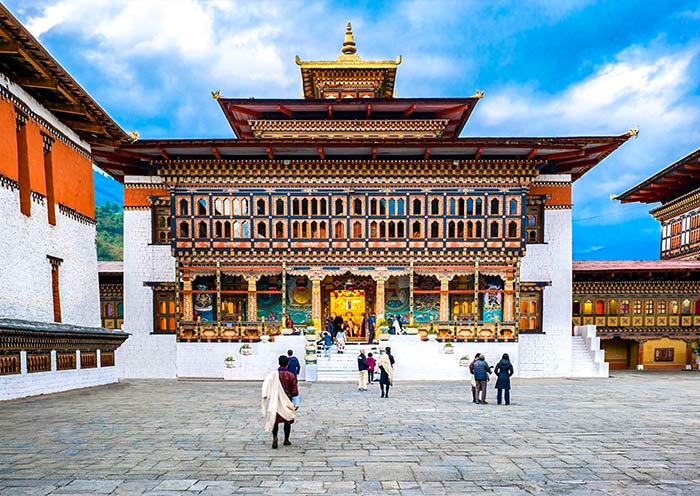
Today, your guide and driver will accompany you on a full-day cultural tour in Thimphu.
You will visit the iconic landmark of Thimphu city - the Buddha Point first. It is the largest sitting Shakyamuni statue in the world that completed in 2015. The statue embodies an ancient prophecy of radiating happiness and peace throughout the world. In addition to admiring its impressive height of 51.5 meters, constructed of bronze and gilded in gold, you will also be able to see 125,000 smaller Buddha statues placed within it. Moreover, from this vantage point, you can enjoy a magnificent view of the Thimphu Valley.
As the largest city in Bhutan, Thimphu lacks traffic lights and a railway system. When you drive back to the city, you can visit the National Memorial Chorten and experience it as the locals do. It is customary to follow the footsteps of the Bhutanese people and perform a clockwise kora (circumambulation) around the Chorten while offering prayers. This will provide you with numerous opportunities to engage with the locals and learn about their daily lives, as well as their philosophy on happiness.
The National Memorial Chorten is the most visited landmark in Thimphu. Constructed in 1974 in memory of the Third King, His Majesty Jigme Dorji Wangchuk (known as the Father of Modern Bhutan), by his mother, it reflects the late king's vision of promoting world peace and prosperity. The Chorten follows a Tibetan-style architecture and is adorned with remarkable paintings and intricate sculptures. You can observe the traditional stupa design, featuring a pyramidal pillar topped with a crescent moon and sun.
At noon, you can visit the Folk Heritage Museum for a traditional Bhutanese Lunch. The museum was established in 2001 through the initiative of Her Majesty Ashi Dorji Wangmo Wangchuck, the Queen Mother of Bhutan (Mother of the 5th King). It is housed in a three-storied, 19th-century traditional house, offering visitors a glimpse into the traditional Bhutanese lifestyle. The museum showcases artifacts from rural households, including a collection of typical household objects, tools, and equipment.
In the afternoon, you can pay a visit to the Bhutan Post Office Headquarters (General Post Office) first for fully functional stamp printed with a self-portrait. This post office is known for housing the world's largest photo book and an intriguing collection of Bhutanese stamps. It is the only place where you can obtain personalized stamps featuring your own face. (Open hours for the post office: Weekdays: 9AM - 5PM; Saturdays: 9 AM - 1 PM; Closed on Sundays).
Then, you can visit School for Arts and Crafts, also known as the Thimphu National Institute for Zorig Chusum, and delight in the abundance of Bhutan's traditional arts and skills. This institution showcases the mastery of the country's 13 arts and crafts, offering a captivating experience of Bhutan's rich artistic heritage. Students here undergo rigorous training for 4-6 years, mastering the techniques and artistic nuances of their chosen craft. The 13 art forms are Traditional Painting, Sculpturing, Wood Carving, Calligraphy, Papermaking, Bronze Casting, Embroidery, Weaving, Carpentry, Masonry, Bamboo and cane weaving, Gold/Silver Smithy, and Black smithy.
Other Free Time Ideas:
1. If you arrive between Thursday and Sunday, make sure to visit the Thimphu Weekend Market.
2. Enjoy a leisurely evening stroll to the Craft Bazaar, where over 80 stalls showcase the traditional handicrafts and creations of local artisans, offering you a delightful shopping experience.


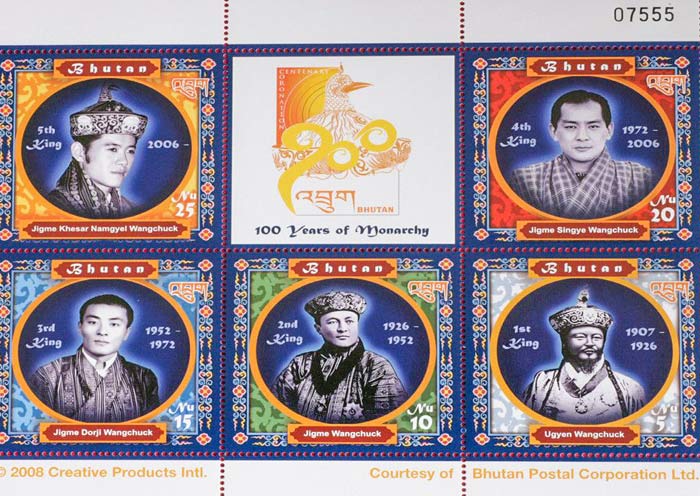
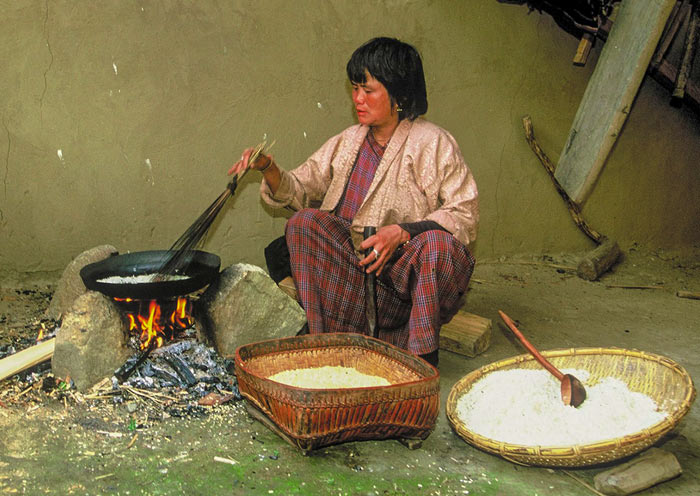
Today, you will travel from Thimphu to Punakha via Dochula Pass (74km, about2.5 hours). This trip is more than just a drive; it is a voyage through changing altitudes and diverse landscapes, offering a visual spectacle. Starting from the higher altitude and cooler climate of Thimphu (2,300m), the drive takes you along the national highway, ascending through the majestic Dochula Pass (3,120m). Upon crossing the pass, you'll descend into the warm and verdant Punakha Valley (1,330m).
En route, you will stop at Dochula Pass (Dochu La Pass), renowned as one of the most beautiful mountain passes in Bhutan. If weather permits, you will be treated to a breathtaking panoramic view of the Himalayas, including Bhutan’s highest mountain peak, Mt. Gangkar Puensum (7,570m). You will have the delightful option to savor the view while enjoying a cup of coffee in the picturesque cafeteria. At the Dochu La Pass summit, you will encounter the 108 memorial chortens (Buddhist shrines) and clusters of prayer flags fluttering in the wind, creating an ambiance of tranquility and spirituality. These chortens (stupas), known as Druk Wangyal Khang Zhang Chortens, were constructed as a memorial to honor the Bhutanese soldiers who lost their lives in the battle against Assamese insurgents from India, and also as an offering for global peace.
Then, your journey continues towards Punakha. Along the way, you will take a hike to Chimi Lhakhang (Chime Lhakhang), which is highly recommended as a culture shock tour. As you stroll through rice paddies and a charming settlement adorned with painted houses and numerous craft shops, you will eventually reach Chimi Lhakhang (Fertility Temple). Constructed by the cousin of Drukpa Kunley, the temple was built to commemorate the victory of Drukpa Kunley (Mad Saint & Divine Madman) over the demon of Dochu La using his "magic thunderbolt of wisdom "(phallus). That is why you can see the symbol of the phallus scattered throughout. Lama Drukpa Kunley was adored by the local people due to his unconventional teaching methods of Buddhism, which involved singing, humor, and an exaggerated manner often intertwined with sexual overtones. Chime Lhakhang is renowned as a sanctuary of fertility, and many childless women sought blessings from the lamas at the monastery. It is believed that these couples often find success in conceiving soon after their visit. If you are lucky, you may encounter the monks there blessing pilgrims or women who wish to conceive by tapping their heads with a 25cm wooden phallus. In Bhutan, it is common for local people to utilize the phallus symbol to ward off the evil eye and deter malicious gossip.
Overnight in Punakha and get ready for your next day's trip.
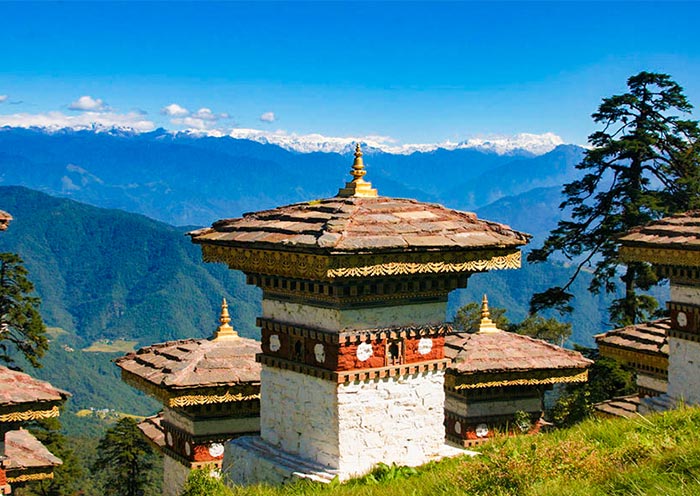

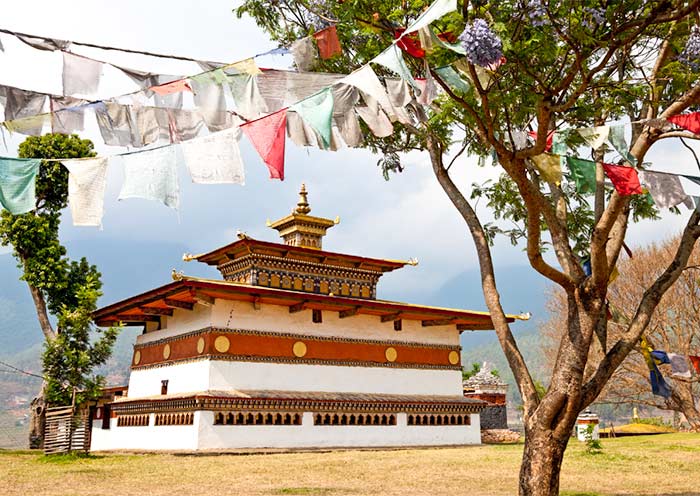
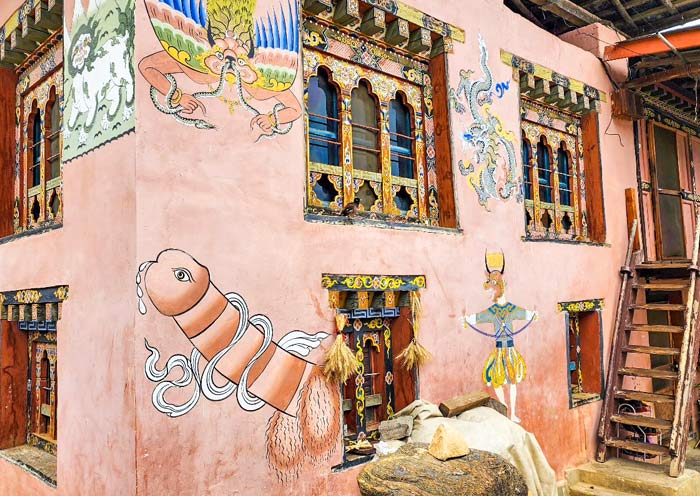
This morning, you will do a hike to Khamsum Yulley Namgyal Chorten (hike 1 hour or less). Along the way, you may encounter farmers working in the fields, either manually or with the help of an ox and plow. The Khamsum Yulley Namgyal Chorten (Stupa) was built in 1990 by the Queen Mother, Ashi Tsering Yangdon Wangchuck, who is the mother of the 5th King Jigme Khesar Namgyel Wangchuck. The purpose of its construction was to ward off evil forces and bring peace to Bhutan and the world. From there, you can enjoy expansive views of the Punakha Valley.
Then, you can head to Punakha city, the old capital of Bhutan before 1955. It is located at the confluence of the Mo Chhu (Mother River) and Pho Chhu (Father River). Dominating the river junction is the magnificent Punakha Dzong, the winter residence of Je Khenpo (head abbot of Bhutan) and about 1,000 monks. Occasionally, you'll spot monks draped in red robes passing by, their rhythmic chanting and prayers echoing in the air. Punakha Dzong, the second oldest and second largest Dzong in Bhutan serving administrative and monastic functions holds a legendary tale. It is said that Guru Rinpoche (Padmasambhava) prophesied the arrival of a person named Namgyal built a Dzong on a hill resembling an elephant. In 1637, Shabdrung Ngawang Namgyel, the unifier of Bhutan, received a divine vision guiding him to construct a Dzong at this site. All of Bhutan’s kings have been crowned here and In 2011, the Dzong bore witness to the royal wedding ceremony of His Majesty Jigme Namgyel Wangchuck, the 5th King of Bhutan, as he married Queen Jetsun Pema. As the most beautiful Dzong in Bhutan, if you visit in April, you won’t miss the stunning violet blossoms of the jacaranda tree outside Punakha Dzong. The jacaranda typically blooms from late March to early May, During this time, the grounds of Punakha Dzong transform into a magical carpet of purple under the clear blue skies, creating a truly breathtaking sight. If you visit during the Punakha Tshechu Festival, you can enjoy the mesmerizing masked dances and witness the exhibition of a large thangka depicting the Zhabdrung (Shabdrung, the father of Bhutan) once a year. You can have fun with locals who flood here dressed in Bhutan’s national attire, with men wearing Gho and women wearing Kira.
After crossing the Bazam Bridge, you can walk inside the Punakha Dzong and take your time to admire this stunning example of Bhutanese Dzong architecture which was built of stone, pounded mud, and a considerable amount of timber (without nails, written plans or designs). There is a six stories central tower called utse standing in the yard of the Punakha Dzong. As the highest architecture within the Dzong, utse houses the most sacred temples and shrines and contains important religious artifacts, thangkas, statues, and texts. This Dzong has three docheys (courtyards) instead of the usual two. The first (northern) courtyard is for administrative functions and houses a huge white Victory Chorten and Bodhi tree. The second courtyard houses the monastic quarters and is separated from the first by the utse. In this courtyard, there are two halls; one of Ugyen Wangchuck (the King of Bhutan) and another hall where the King was decorated in 1905 with the Order of the Knight Commander of the Indian Empire by John Claude White. In the third (southernmost) courtyard is the temple where the remains of the Pema Lingpa (a treasure revealer, Five Terton Kings) and Shabdrung (founder of Tshechu Festival and Bhutan National Dress) are preserved. At the south end, there is the kunrey, or "hundred-pillar" assembly hall with exceptional murals that depict the life of Buddha.
After exploring the Punakha Dzong, your journey continues with an opportunity to cross one of Bhutan’s longest pedestrian suspension bridges over the Po Chhu River. By walking across this 160-meter Punakha Suspension Bridge, you will be treated to breathtaking views of the lush Punakha Valley and the glacier-fed Po Chhu River below.
Optional Bhutan Punakha Experience:
Punakha Rafting: You have the option to go rafting in the Po Chu and Mo Chu rivers, offering unique views of the Punakha Dzong that are not possible from land.
After that, go back to your hotel.


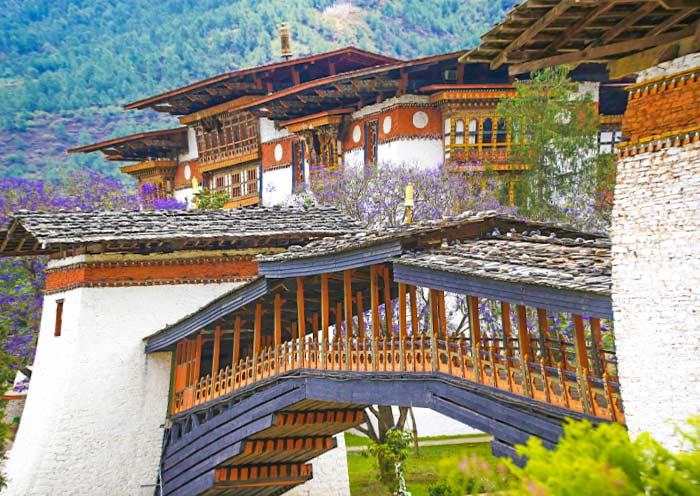

This morning, you will head to Gangtey (73km, 2.5h), Phobjikha Valley which is a U-shaped glacial valley on the western slopes of the Black Mountains, bordering the Jigme Singye Wangchuck National Park. The valley houses one of the impressive ancient Buddhist monasteries in Bhutan known as Gangteng Monastery, and as a result, some people refer to this entire region as Gangtey. Because of the large flock of black-necked cranes that winters here, it is one of the most important wildlife preserves in the country. It offers beautiful trails for hiking and nature walks, allowing visitors to experience its tranquility and natural beauty up close.
In the afternoon, after a rest in your hotel, you can have a light hike on Gangtey Nature Trail (4km, 1.5-2 hours) that starts from Gangtey Monastery (3030m) and descends to Khewang Lhakhang (2850m). It is the most beautiful and shortest of the existing nature trails in Bhutan. You can immerse yourselves in the beauty of the Phobjikha Valley (2840m) with farmhouses, dense pine forests, rhododendron forests, and bamboo plants on foot and get a glimpse of the rural and pastoral lifestyle. During the winter (between late October and late February), it may be a bonus to see the rare and endangered Black-neck Cranes. Tips:1.Dress in layers and wear comfortable hiking shoes. The weather can change quickly in the mountains. 2. Respect wildlife and maintain the cleanliness of the trail.
Gangtey Monastery (Gangtey Goemba, Gangtey Gonpa) was first built in 1613 by Pema Thinley, the grandson, and re-embodiment of Pema Lingpa (the reincarnation of Guru Rinpoche, 1450-1521). It is a beautiful temple architecture that stands on the hilltop and is a great spot to view the picturesque Phobjikha Valley. The Monastery's history traces back to the prophecies made by the well-known Terton (treasure finder) Pema Lingpa in the late 15th century that a goemba (monastery) named gang-teng (hilltop) would be built on this site and that his teachings would spread from here. Now the Monastery is one of the main seats of the religious tradition based on Pema Lingpa's revelations and one of the two main centres of the Nyingmapa school of Buddhism in the country. It is said that on arrival in the Phobjikha Valley in the last week of October, the black-necked cranes circle the Gangteng Monastery three times and also repeat the process while returning to Tibet. Bhutanese have great respect for these “heavenly birds”. Each year on Nov. 11, the Black-necked Crane Festival with local songs, dramas, and masked dances is held at the courtyard of Gangtey Goemba to celebrate the arrival of the endangered bird migrating from the Tibetan Plateau.
At the end of the trail, you will find Khewang Lhakhang, located on the east side of the Phobjikha valley. This 15th-century temple is one of the oldest in the valley and it showcases three impressive two-storey statues of the past, present, and future Buddhas (dusum sangay).
In the late afternoon, you can also pay a visit to the Black-necked Cranes Information Center, which has informative displays about the black-necked cranes and the valley environment. You can enter the observation room and use the telescope and spotting scopes to watch the Black-necked crane (Grus nigricollis). Every year (Oct. to Feb.), over 300 cranes migrate from Tibet to Bhutan for their winter months in Phobjikha Valley. It has been helpful for the center to protect and conserve the Black-necked crane and its species since 2003. It is a nice place to know more about the cranes and study their behavior. After that, drive back to your hotel in Gangtey.




In the morning, make your way back to Paro (170km, about 5h) via Dochu La Pass. On the way back to Paro, you won’t miss the famous Tamchog Lhakhang (Tachog Lhakhang), situated by the Paro river. There, you will have the opportunity to walk across a unique iron chain bridge adorned with colorful fluttering prayer flags. Both the Lhakhang and the iron bridge were constructed by the revered saint Thangthong Gyalpo (1385 - 1464), who was renowned as the Iron Bridge Maker. Take delight in exploring his historic architectural creations that have stood the test of time.
In the afternoon, after a rest in your hotel, you can pay a visit to Paro Dzong and the Bhutan National Museum.
Paro Dzong (Rinpung Dzong) is a magnificent fortress stands tall and proud, serving as a beacon of history and culture in Bhutan. Rinpung Dzong was constructed in 1646 by Shabdrung Ngawang Namgyal (1594-1651), a pivotal figure in Bhutanese history who is revered as the founder of the modern Bhutanese state and a national hero. His enduring legacy continues to shape the country's identity and cultural landscape. Located near the pristine Paro Chu River, Paro Dzong can be accessed via a traditional wooden cantilever bridge, providing you breathtaking panoramic views of the enchanting Paro Valley. If you hike a little further, you will reach the Bhutan National Museum (Ta Dzong), which holds the distinction of being Bhutan's tallest building. Originally constructed in 1649 as a watchtower overlooking the Paro Dzong, it was later transformed into the National Museum of Bhutan in 1968. At the museum, you can immerse yourself in a rich collection of ancient artifacts such as pottery, armor, thangkas, masks, stamps, photographs, statues, costumes, relics, stone axes, and religious paintings.
For nature and culture lovers, Paro is a picturesque place that combines spirituality, natural beauty, and cultural heritage. You may have the chance to attend the colorful annual Paro Tshechu Festival if you visit Paro in early to mid-March. The festival falls on the 10th day of the second lunar month of the Bhutanese calendar. In some years, the festival might start slightly earlier, around March 10th or 15th. The festival celebrates the birthday of Guru Rinpoche, a revered figure in Bhutanese Buddhism.
Free Time Ideas:
1. Visit Paro Local Market: Why not dress in Bhutan's National attire to visit the Paro Local Market? Check what Bhutanese eat for their daily life? What is include in Bhutan Dishes? Colorful Chili peppers, dry cheese, potatoes, apples...
2. Try Bhutan National Game (self-pay for the fee): Archery is the favorite pastime for Bhutanese. It has a history of over 2,000 years and was declared Bhutan's National Sport in 1971. Targets at traditional Bhutanese tournaments are placed at both ends of a 140m range (Olympic distance is 70m). Enjoy your time by holding a bow and arrow.
3. Bhutanese Wood Turning (Shagzo): Visit a small factory specializing in produce bowls (dapa), cups (dza phob), plates, and containers ranging a wide gamut of shapes, sizes, and colors. These products are crafted from special wood burls and tree roots found in Bhutan. Traditionally, wooden bowls and cups are used to serve food in Bhutanese households.
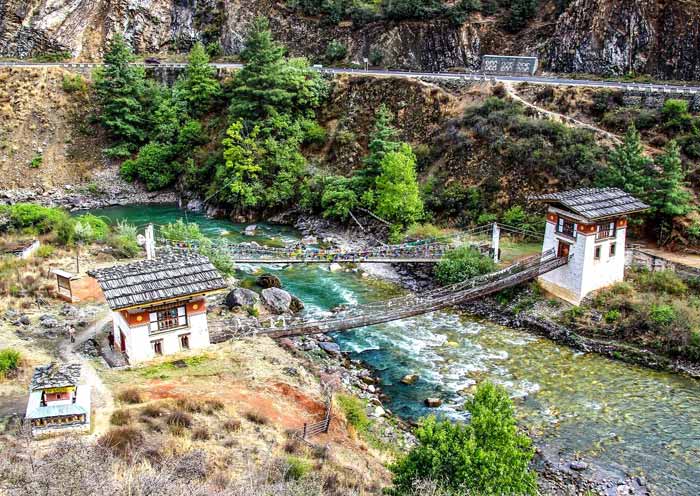


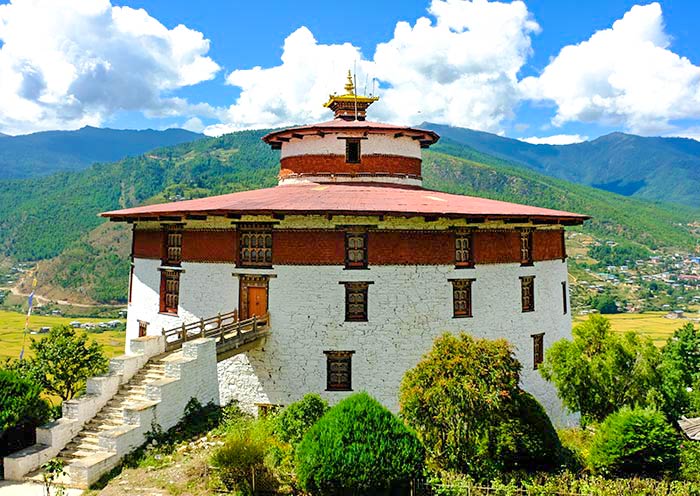
This morning, you will enjoy the exciting hiking tour to Tiger's Nest, the landmark of Bhutan and the most famous holy monastery in the country. It is about a 22 km drive (1 hour) away to the start point of the Tiger's Nest hike route.
Usually, it may take about 2.5 hours to reach Tiger's Nest Monastery (Paro Taktsang) on foot. The entire Tiger's Nest Hike takes around 5 to 6 hours, with about 2.6km of uphill trekking and about 2.6km of downhill walking. You have the option to rent a horse at the designated place if you prefer. Riding a horse (self-payment required) takes about 1.5 hours to reach the halfway point on the mountainside. From there, you need to say goodbye to your horse and hike for another 1.5 hours to reach the Tiger's Nest Monastery. At the halfway point, there is a Taktsang Cafeteria where you can have a buffet lunch and enjoy coffee and tea. What is more, it is the first viewpoint where you can look up Tiger's Nest Monastery, the incredible religious site of Buddhists. As the viewing position ascends, the outline of Tiger's Nest Monastery becomes increasingly clear. On the journey ahead, you can enjoy the hike in Bhutan’s forest and will see more and more prayer flags and prayer wheels, left behind by the Bhutanese people who come here to worship. You will also have a panoramic view of the beautiful Paro Valley below. If you visit in April, you will have the opportunity to see the high-altitude rhododendrons blooming, creating a stunning display of red clouds amidst the mountains.
Then, you will stand right opposite the Taktsang Goemba (Tiger's Nest Monastery) and admire Bhutan's most iconic cultural landmark, which is renowned as one of the world's top ten super monasteries. The Tiger's Nest (3,120m) is situated on the side of a cliff at a height of 900m above the Paro Valley (2,270m). According to legend, the Indian sage Guru Padmasambhava (Guru Rimpoche, the founder of the Nyingma school of Tibetan Buddhism and the builder of the first monastery in Tibet - Samye Monastery) arrived at the location of Tiger's Nest Monastery in the 8th century. It is said that he rode a tigress and subdued demons before spending 3 months meditating in the mountain caves here. This eventually led to the formation of the present-day Tiger's Nest Monastery. Throughout history, this place has been considered a sacred site by Buddhist luminaries. However, it wasn't until 1692 that the current structure of Tiger's Nest Monastery took shape. In 1998, a devastating fire caused significant damage, but it was reconstructed in 2005, closely resembling the original architectural design. If you are interested you can hike into the monastery to explore more (no photo inside). Today, Tiger's Nest Monastery, one of the most visited tourist attractions in Bhutan, is revered as the holiest pilgrimage site for Bhutanese people to visit at least once in a lifetime.
After completing the Tiger's Nest hike, you will proceed to Drukgyal Dzong, where you will have the opportunity to catch a glimpse of Mount Jomolhari (7,570m). Known as the "Mountain Goddess" and the tallest mountain in Bhutan, Mt Jomolhari is considered a sacred abode for deities and spirits, earning the title of "Sacred Mountain". Know as the Fortress of the Victorious Drukpa, Drukgyal Dzong was believed to have been built in 1646 by Zhabdrung Ngawang Namgyal who is the unifier and founder of the Bhutanese nation-state. The building was used as an administrative center until 1951 when a fire caused by a butter lamp destroyed it. In April 2016, to celebrate the birth of the Dragon Prince, Gyalsey His Royal Highness Jigme Namgyel Wangchuck, as well as to commemorate the arrival of Zhabdrung Ngawang Namgyel to Bhutan in 1616 AD and the birth year of Guru Rinpoche, then Prime Minister Tshering Tobgay announced that the dzong will be restored and reinstated to its former glory upon the command of His Majesty King Jigme Khesar.
Then, it is time to visit Kyichu Lhakhang, also known as the Temple of the Thousand-armed and Thousand-eyed Avalokiteshvara. It is one of the 108 Buddhist temples built by King Songtsen Gampo in the 7th century (around 659 AD), and it is believed to have been constructed to subdue the left leg of the Tibetan witch. Kyichu Lhakhang is also one of the oldest Tibetan Buddhist temples in Bhutan and serves as a venue for important celebrations of the Bhutanese royal family. In the main hall of Kyichu Lhakhang, you can see the revered statue of an eight-year-old Shakyamuni Buddha, believed to have been created during the same period as the Jowo statue in the Jokhang Temple in Lhasa, Tibet. It is considered a national treasure of the Kingdom of Bhutan. Apart from housing many precious historical artifacts and Buddhist scriptures, the temple also enshrines the relic stupa of Dilgo Khyentse Rinpoche (1910-1991), a renowned master of the Nyingma tradition. Additionally, there is a piece of iron chain forged by Tangtong Gyalpo, who was the former head of the four major Tibetan Buddhist schools and is known as the Iron Bridge Living Buddha and the father of Tibetan opera.
Kind Reminds:
1. The best time to visit Tiger's Nest is from March to May and from October to December. After noon, the monastery will be hidden in the shadow of the cliffs, so it's recommended to depart early if you want to capture good photos.
2. Tiger's Nest offers horse riding services to go uphill, but the horse ride is only available up to a designated point. From there, you still need to hike to reach the monastery. When descending, you must walk the entire way as horse riding services are not provided.
3. Mobile phones and backpacks are not allowed inside Tiger's Nest Monastery. Personal belongings can be stored at the entrance. If you wish to light butter lamps, make sure to have some cash ready before storing your belongings.
4. Along the way, you may encounter stray dogs. Please be mindful, give them space, and avoid disturbing them.
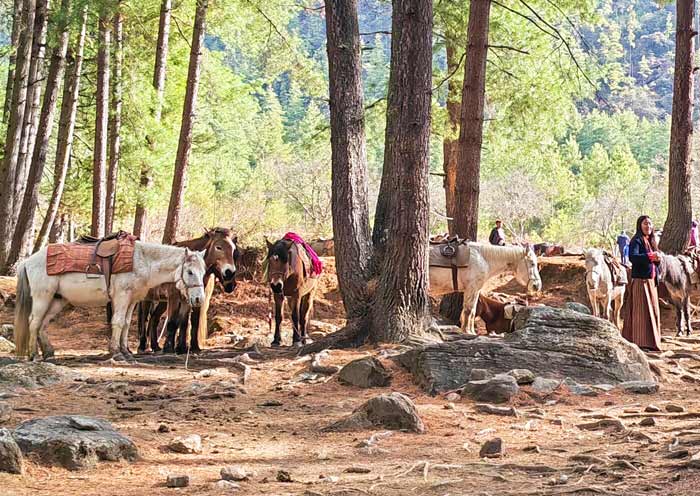



Happiness is a place, wish you had gotten your happiness philosophy from the beautiful Himalayan country with us. It is time to end your 10-day Thailand Bhutan Tour. Your guide will escort you to Paro International Airport for your flight to your next destination.
Extension Ideas:
1.If you prefer to travel longer in Bhutan, you can extend your trip to other highlighted parts of Bhutan, such as Haa and Bumthang.
2.If you prefer to travel longer in Thailand, you can extend your trip to other highlighted parts of Thailand, such as Chiang Mai, Phuket, Chiang Rai, Krabi, Koh Samui, etc.
3.If you plan to continue exploring neighboring countries in Southeast Asia or Asia, such as Vietnam, Cambodia, Laos, Nepal, India, or China, don't hesitate to let us know. We can customize your itinerary and assist with travel arrangements.
Thank you for choosing Asia Odyssey Travel (AOT) for your Bhutan tour, we are always here working for you and hope to see you again for your next trip to Asia. Safe journey!




Price: What’s Included & What’s Excluded
What's Included:
What's Excluded:
Important Travel Tips
Before your trip, it is important to check the visa requirements for each country and ensure that you have all the necessary documents.
Hotel Conditions for Your Tour




To cater to various travelers' preferences and budgets, we offer a range of carefully chosen accommodations, including luxurious 5-star hotels, comfortable 4-star options, and economical 3-star establishments.
Find your perfect hotel for a great experience: We offer a diverse selection of hotels, catering to all types of travelers. Our knowledgeable travel experts can provide you with various pricing options based on different hotels. Whether you seek a luxurious stay or have specific preferences, our experts will assist you in choosing the best option that suits your needs.
Photo Gallery for This Itinerary
Latest Thailand Tours Reviews from Our Customers

Jan Woolley
USA
Date of Experience: Apr 26, 2024
Tour Customized by: Tony
You May be Interested in This Tour: Customized Tour

Poppyisblonde
Australia
Destination(s): Other
Date of Experience: Sep 23, 2022
Tour Customized by: Nicole
You May be Interested in This Tour: Customized Tour

Laura
US
Destination(s): Other
Date of Experience: Aug 22, 2023
Tour Customized by: Amy
You May be Interested in This Tour: Customized Tour
Price: Request
(Based on a private tour for two people. Price varies depending on program, travel date, number of people.)
Free Enquiry! You don’t need to pay for the reservation.
- United States (+1)
- Australia (+61)
- Singapore (+65)
- Malaysia (+60)
- Philippines (+63)
- Canada (+1)
- Italy (+39)
- Indonesia (+62)
- United Kingdom (+44)
- Spain (+34)
- Mexico (+52)
- Hong Kong (+852)
- Thailand (+66)
- United Arab Emirates (+971)
- New Zealand (+64)
- South Africa (+27)
- Germany (+49)
- Brazil (+55)
- India (+91)
- France (+33)
- Vietnam (+84)
- The Netherlands (+31)
- Saudi Arabia (+966)
- Ireland (+353)
- Argentina (+54)
- Switzerland (+41)
- Romania (+40)
- Pakistan (+92)
- Japan (+81)
- Portugal (+351)
- Bangladesh (+880)
- South Korea (+82)
- Puerto Rico (+1)
- Türkiye (+90)
- China (+86)
- Belgium (+32)
- Qatar (+974)
- Greece (+30)
- Taiwan (+886)
- Austria (+43)
- Poland (+48)
- Israel (+972)
- Chile (+56)
- Sri Lanka (+94)
- Nigeria (+234)
- Peru (+51)
- Colombia (+57)
- Hungary (+36)
- Nepal (+977)
- Denmark (+45)
- Bulgaria (+359)
- Norway (+47)
- Slovenia (+383)
- Sweden (+46)
- Kuwait (+965)
- Costa Rica (+506)
- Ecuador (+593)
- Venezuela (+58)
- Malta (+356)
- Croatia (+385)
- Tunisia (+216)
- Czechia (+420)
- Mongolia (+976)
- Bahrain (+973)
- Mauritius (+230)
- Papua New Guinea (+675)
- Cambodia (+855)
- Dominican Republic (+1)
- Luxembourg (+352)
- Finland (+358)
- Guatemala (+502)
- Myanmar (+95)
- Maldives (+960)
- Slovakia (+421)
- Laos (+856)
- Serbia (+381)
- Brunei (+673)
- Oman (+968)
- Macao (+853)
- Panama (+507)
- Morocco (+212)
- Jordan (+962)
- Georgia (+995)
- Fiji (+679)
- Bolivia (+591)
- Lithuania (+370)
- Bahamas (+1)
- Cyprus (+357)
- Latvia (+371)
- Bhutan (+975)
- Iraq (+964)
- Iran (+98)
- Kenya (+254)
- Jamaica (+1)
- Zimbabwe (+263)
- Azerbaijan (+994)
- Uruguay (+598)
- Estonia (+372)
- Andorra (+376)
- Cameroon (+237)
- Ghana (+233)
- Kazakhstan (+7)
- Nicaragua (+505)
- Egypt (+20)
- Russia (+7)
- Albania (+355)
- Réunion (+262)
- Montenegro (+382)
- Algeria (+213)
- Afghanistan (+93)
- Martinique (+596)
- Uganda (+256)
- Honduras (+504)
- North Macedonia (+389)
- Trinidad and Tobago (+1)
- Suriname (+597)
- Antigua and Barbuda (+1)
- Zambia (+260)
- Ukraine (+380)
- Armenia (+374)
- Barbados (+1)
- Belarus (+375)
- Palestine (+970)
- Lesotho (+266)
- Moldova (+373)
- Ethiopia (+251)
- French Polynesia (+689)
- Gambia (+220)
- Guam (+1)
- Gibraltar (+350)
- Isle of Man (+44)
- New Caledonia (+687)
- El Salvador (+503)
- Comoros (+269)
- Seychelles (+248)
- Chad (+235)
- Samoa (+685)
- Cook Islands (+682)
- Palau (+680)
- Paraguay (+595)
- DR Congo (+243)
- Solomon Islands (+677)

